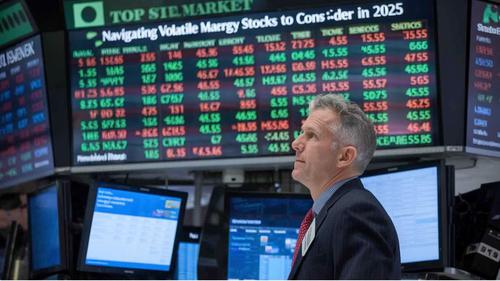MarketLens
Should Equity Investors Consider the Japan ETF EWJ in 2024?
The iShares MSCI Japan ETF (EWJ) is one of the most popular options for investors seeking exposure to the Japanese equity market in 2024 and beyond. With over $20 billion in assets under management (AUM), EWJ tracks the MSCI Japan Index and provides access to a broad range of large- and mid-cap Japanese stocks.
Understanding the Basics of EWJ and its Role in 2024’s Market
EWJ offers exposure to around 300 Japanese companies across multiple sectors. The information technology sector has the highest allocation at 22%, followed by consumer discretionary at 18%. EWJ’s top 10 holdings makeup over 20% of the ETF’s portfolio.
Launched in 1996, EWJ has firmly established itself as the go-to Japan ETF with a lengthy track record and expense ratio of 0.50%. As Japanese stocks remain attractive in 2024 amid share buybacks, dividend growth, and reforms, EWJ stands out for its liquidity and potential for capital appreciation.
What Makes EWJ Stand Out Among Japanese Equities?
Unlike other single-country ETFs, EWJ is highly liquid with an average daily trading volume over $700 million on the Nasdaq exchange. This makes it easy for investors to buy or sell shares of EWJ efficiently.
Additionally, EWJ provides exposure strictly to large and mid-sized companies in Japan. This contrasts with funds like WisdomTree Japan Hedged Equity Fund (DXJ) and JPMorgan BetaBuilders Japan ETF (BBJP) that incorporate smaller firms as well.
EWJ’s Performance: A Glimpse into Past and Future Potentials
Over the past decade, EWJ has closely tracked the performance of Japanese equities as measured by common benchmarks like the Nikkei and TOPIX. This strong long-term correlation is expected to continue in 2024 amid an improving economic outlook.
Historically, EWJ has posted solid returns in years when exports and corporate earnings in Japan outperform. As macro conditions remain supportive in 2024, analysts expect EWJ could deliver double-digit returns, outperforming broad indexes like the S&P 500.
The Impact of Japanese Market Trends on EWJ in 2024
Several positive trends in Japan’s economy and equity market could catalyze EWJ’s performance in 2024:
- Corporate reforms – Changes in governance regulations have led firms to focus more on shareholder returns via dividends and buybacks.
- BOJ policy – The Bank of Japan’s accommodative stance supports equities and weakens the yen, boosting exporter stocks.
- Global growth – Stronger worldwide growth, especially in the US and China, spells greater demand for Japanese exports.
These tailwinds are already reflected in Japanese companies’ earnings growth and stock valuations. As reforms accelerate further in 2024, stocks like those in EWJ’s portfolio stand to benefit tremendously.
Portfolio Diversification: How EWJ Fits into Global Equity Strategies
With its heavy allocation to export-oriented sectors, EWJ offers diversification benefits in a global equity portfolio. Having low correlation to US and European markets, adding EWJ can enhance overall returns while reducing volatility.
In 2024 and beyond, EWJ remains a stable option for investors seeking to tap into Japan’s equity market growth without taking on currency risk directly. For those willing to hedge currency exposure, ETFs like DXJ may be better suited.
Comparing EWJ with Other Japanese and Global ETFs
Compared to Japan-focused ETFs like DXJ and BBJP, EWJ stands out for its lower expense ratio, higher liquidity, and broader exposure. Relative to global ETFs, EWJ allows concentrating bets on Japanese equities where tailwinds persist in 2024.
Based on holdings, sector allocations, costs, and historical returns, EWJ has proven itself as an efficient avenue to benefit from Japan’s structural shifts and cyclical upturn in the economy.
The Importance of Diversification in Equity Investment
While EWJ offers exciting potential in 2024, it is prudent not to allocate more than 5-10% of the equity segment to Japan or any single country. Maintaining adequate diversification across geographies, assets classes, market caps, and sectors reduces volatility.
As with all equities, EWJ’s past performance does not guarantee future returns either. Regular portfolio rebalancing and staying updated on financial metrics and news is key to mitigating risks associated with EWJ or any ETF/stock.
Allocating EWJ in an Equity Portfolio for 2024
Within a diversified portfolio, a 5% allocation to EWJ seems reasonable given the positive momentum in Japanese stocks. This allows benefiting from the upside while limiting concentration risk.
For more aggressive investors, a 10% allocation to Japan split across EWJ and currency-hedged ETFs like DXJ and WisdomTree Japan Hedged Equity Fund ETF makes sense in 2024 amid a weak yen outlook.
Evaluating the Valuation: Is EWJ Priced Right for 2024 Investment?
Based on forward price-to-earnings (P/E) and price-to-book ratios, Japanese equities appear attractively priced currently compared to global peers. The TOPIX trades at a forward P/E of 12x versus 18x for the S&P 500 index.
Within Japan’s market, export-oriented large-cap stocks have rebounded sharply in 2023, now trading in line with historical averages. However, valuations remain appealing relative to growth forecasts for 2024 and beyond.
Analyst Opinions and the Valuation of Japanese Equities
Most analysts remain bullish on Japanese stocks in 2024, forecasting average upside of over 15% this year. Firms like Goldman Sachs, UBS, and Nomura see further expansion in P/E multiples as corporate governance reforms start bearing more fruit.
Specifically for EWJ, analysts highlight its reasonable valuation and sensitivity to stock buybacks and dividend increases going forward. As payouts grow in Japan, EWJ’s total return profile becomes even more compelling.
Exploring the Price-to-Earnings Ratio of EWJ ETF
Trading at a forward P/E of 12x, EWJ’s valuation aligns closely with broader Japanese indexes. This represents over a 15% discount compared to other developed market benchmarks.
Notably, the P/E ratio for EWJ has jumped from a low of 10x in early 2022 to now 12x on appreciation of over 25% in Japanese equities since then. Further upside remains likely as earnings play catch up.
The Role of Yen Fluctuation in EWJ Valuation
As an unhedged ETF, EWJ’s returns have a positive correlation with the yen/dollar exchange rate. A weaker yen boosts profits for exporters, driving gains for EWJ.
The BOJ’s dovish stance has contributed to the yen depreciating 10% against the dollar in 2023. Further weakness is expected in 2024 as policy divergence with the Fed persists. This provides a valuation tailwind for unhedged Japan ETFs like EWJ.
The Dividend Yield of EWJ: Understanding its Attractiveness to Investors
Currently, EWJ has a trailing 12-month dividend yield of 2.3%. This positions it favorably compared to the S&P 500 and global equity indexes which yield around 1.8% each.
Within Japan-focused ETFs, EWJ’s dividend yield is higher than that of DXJ and on par with BBJP. The improving payout profile adds to EWJ’s positive investment case in 2024.
Comparing Dividend Yields: EWJ vs. Competing ETFs
EWJ offers a healthy income stream with its 2.3% dividend yield, comparing well to alternatives like Vanguard’s Total World Stock ETF at 2.1%. The S&P 500 ETF (SPY) lags with a sub-2% yield.
Versus other single-country ETFs, EWJ also scores well. The UK ETF (EWU) and Germany ETF (EWG) have yields below 2% each. For Japan exposure, EWJ strikes the right balance between income and growth.
How Japanese Corporate Governance Reforms Impact Dividends
Structural shifts in Japan’s corporate landscape are driving a secular uptrend in dividends and buybacks. Under Prime Minister Kishida, governance reforms have accelerated pressuring companies to increase payouts.
As activism from foreign investors rises further, management teams are likely to channel more free cashflows to shareholders. This directly benefits EWJ investors through its 2%+ dividend stream.
Forecasting Dividend Growth for EWJ Holders in 2024
Consensus estimates forecast over 8% dividend growth for Japanese firms in 2024 on average, ranging between 5-12% for individual companies. For EWJ investors, this suggests another year of rising payouts.
Assuming a conservative 7% dividend hike this year, EWJ’s trailing yield would rise to 2.5% over the next 12 months. Including capital gains, total return prospects seem extremely strong.
Hedging Strategies: Using EWJ to Navigate Currency and Market Risks
While attractive for its diversification benefits, investing in Japan through EWJ brings currency risk given fluctuations in the yen/dollar exchange rate.
For suitable investors, hedging part of the currency exposure through ETFs like DXJ and WisdomTree Japan Hedged Equity Fund makes sense from a risk management standpoint.
Understanding the Correlation Between Yen and EWJ’s Performance
Over the past decade, EWJ’s returns measured in dollar terms have had a correlation of over 90% with the yen/dollar exchange rate. A weaker yen boosts profits for exporters and benefits EWJ disproportionately as a result.
This relationship has strengthened in recent years as monetary policies between the BOJ and Fed diverge. As long as this dynamic persists, currency moves will be a key driver behind EWJ.
Benefits of Incorporating Hedged ETFs like DXJ in Your Portfolio
For investors concerned about currency risk, allocating a portion to DXJ can help smooth overall returns. DXJ neutralizes the impact of the fluctuating yen through hedging strategies.
Blending EWJ and DXJ allows playing both scenarios of yen strength and weakness. This approach capitalizes on positive momentum in Japanese stocks without taking a view on currencies.
Adapting Investment Strategies in Light of Economic Indicators
As macro conditions evolve in 2024, investors should stay nimble and adjust allocations across geographies and asset classes accordingly.
If leading indicators like PMIs signal a slowdown in Japan or major trading partners, paring back exposure to EWJ would help safeguard performance for portfolio.
The Future of Japanese Stocks and EWJ’s Positioning
Japanese equities appear well-positioned for 2024 as corporate reforms accelerate and global demand prospects improve further. Earnings growth should sustain the upward trajectory in stocks over the near-to-medium term.
Within this positive backdrop, EWJ stands out as a liquid, cost-efficient avenue to access large caps levered to shareholder returns and export growth. Its future remains promising.
Influences of Technological Innovations on Japanese Equity Market
As a leading exporter of electronics and hi-tech equipment, Japan stands to benefit from growing tech spending globally in areas like 5G, IoT and EVs.
EWJ provides exposure to these investment themes which are gaining traction. Innovation-linked policy incentives domestically also support technology stocks over the long run.
Corporate Reforms and Their Impact on Companies in EWJ’s Portfolio
Regulatory changes promoting higher governance standards have been a catalyst behind rising dividends and buybacks. Initiatives like Japan’s Stewardship Code have also raised shareholder activism.
Nearly 40% of stocks held by EWJ come from sectors directly impacted by these reforms such as industrials and consumer discretionary. Their profitability and payout ratios continue rising as a result.
Anticipating Market Movements: Bullish vs. Bearish Outlooks for EWJ
In the bullish scenario, Japanese stocks deliver double-digit upside in 2024, fueled by higher capex, overseas demand, and record profits. EWJ’s portfolio of quality exporters and domestic plays shines.
The bear case entails a global recession hitting trade flows and earnings. However, Japan’s undervaluation and linkage to shareholder returns offer resilience. Upside potential for EWJ remains favorable on balance.
Analyst Recommendations for Investing in Japan ETFs vs. Country ETFs
Japanese equities are among the most favored regions for equity investors in 2024 according to investment banks like Goldman Sachs and JPMorgan.
Analysts highlight Japan’s reasonable valuations, exposure to global trade tailwinds and scope for catch-up from lost decades as key reasons to overweight the market next year.
Within the ETFs, they favor broad Japan ETFs like EWJ but also highlight currency-hedged Japan ETFs like DXJ as ways to isolate stock upside from the weaker Yen.
Overall, analysts strongly recommend increasing allocation to Japanese stocks and ETFs in 2024 over other single country and region ETFs.
Related Articles
2025’s Top Sectors: Your Savvy ETF Guide
Category
You may also like
No related articles available
Breaking News
View All →No topics available at the moment






